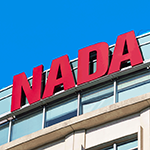NADA Announces “Green Checkup” Month in September
NEW CAMPAIGN SHOWS DRIVERS HOW TO SAVE GAS AND CUT GREENHOUSE GAS EMISSIONS
DENVER (August 18, 2008) - Record gas prices have just about everyone searching for ways to save on gas and improve fuel economy.
To help motorists save money at the gas pump and-at the same time-cut greenhouse gas emissions through proper vehicle maintenance, the National Automobile Dealers Association (NADA) has created a check list of Green Maintenance Tips and a new program called the Green Checkup.
NADA Chairman Annette Sykora announced the Green Checkup campaign at a news conference in Denver.
Governors Bill Ritter, D-Colo., and Arnold Schwarzenegger, R-Calif., also spoke at the news conference, along with the president of the Alliance of Automobile Manufacturers, Dave McCurdy, who introduced his association's EcoDriving initiative, and Dan Grossman with the Environmental Defense Fund.
In her remarks at the conference, Sykora emphasized that the goal of the Green Checkup campaign is to highlight simple steps that car owners can take to maintain their vehicles in top running condition.
“Dealerships are located in every major community in the country which means we are ideally positioned to be at the forefront of a national consumer awareness campaign,” said Sykora, owner of two dealerships in Texas.
NADA is urging its dealer members to offer free Green Checkups at their dealerships. The “Green Checkup” focuses on the things that have the most effect on fuel economy, such as oil and air filters, engine performance, tire pressure and emission controls.
As part of the EcoDriving initiative, McCurdy outlined a national campaign to highlight smart driving habits that can save drivers gas and money, and announced a new Web site that provides valuable EcoDriving information to motorists at http://wwww.ecodriving.usa.com/.
Although NADA is promoting Green Checkup Month in September, the program is designed for dealers to offer checkups as part of their routine service year-round.
This is one example of how dealers are becoming more energy conscious. A trend toward green dealerships is another.
“Dealers around the country have invested close to a billion dollars on facility upgrades and new construction over the past few years to reduce energy consumption at their dealerships,” Sykora said.
This includes cutting-edge heating and cooling methods, more efficient lighting, as well as wind and solar power. Today, several dealerships are LEED certified by the U.S. Green Building Council's Leadership in Energy and Environmental Design program.
“With the growing number of green dealerships and the Green Checkup campaign, we are sending a clear signal that when it comes to climate change, America's new car dealers are part of the solution,” Sykora said.
Contact your local dealership to find out if a “Green Checkup” is being offered in your community and schedule an appointment. The “Green Checkup” only takes about an hour.
Consumers can save money and energy-and wear and tear on their vehicles-with proper care and maintenance. Here are 10 items that affect fuel economy.
NADA's 10-Point Green Checkup
- Motor oil: Top off and change oil as necessary with manufacturer-recommended grade, “energy conserving” motor oils. Doing so can improve fuel economy by up to 2 percent, according to the U.S. Environmental Protection Agency (EPA). Replacing conventional oils with synthetics may offer even greater fuel economy benefits.
- Air filters: Make sure you change your air filter at the end of its recommended lifespan. Replacing a clogged air filter can improve a vehicle's gas mileage by up to 10 percent, according to the U.S. Department of Energy.
- Engine performance: Enhance fuel economy performance by having engines tuned and spark plugs replaced according to the manufacturer's recommended schedule. A single misfiring spark plug can cut fuel economy by up to 4 percent, according to the EPA.
- Brakes: Improperly maintained brakes can result in unwanted drag. This unnecessary resistance can have the same effect as driving with a foot on the brake pedal: a dramatic drop in fuel economy.
- Warning lights for “Service Engine Soon” or “Check Engine:” Ignoring these indicators may result in poor fuel economy performance and require expensive repairs. For example, a warning light may indicate a faulty oxygen sensor is sending more fuel to the engine than necessary, which can result in a 40 percent fuel economy decline. A warning light could also indicate a faulty thermostat, which can prevent a cold engine from reaching its normal operating temperature resulting in the unnecessary injection of fuel.
- Tire wear: Replacing worn tires with a manufacturer-recommended size and style can save hundreds of dollars a year. To improve fuel economy performance, consider low rolling-resistance replacement tires.
- Tire inflation pressure: Keeping tires inflated to at least the manufacturer-recommended pressure can improve fuel economy by up to 3 percent, according to the EPA. Under-inflated tires require more energy to roll, meaning more fill-ups.
- Unnecessary items that add weight to the vehicle: Unnecessary weight lowers fuel economy; remove heavy items from your trunk and back seat.
- Evaporative emission controls: Poorly operating evaporative emission controls can fail to capture gasoline vapors and recycle them to the fuel tank. Faulty controls waste gas and degrade air quality.
- Transmission: Properly operating modern transmissions and drive components are critical to vehicle fuel economy performance. Routinely check proper fluid levels and system operation.
Media Contacts

Jared Allen

